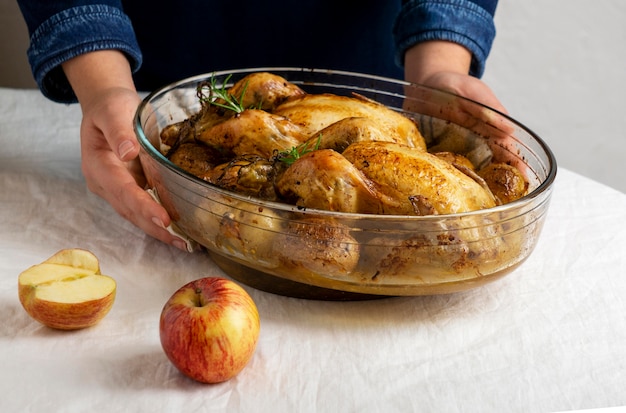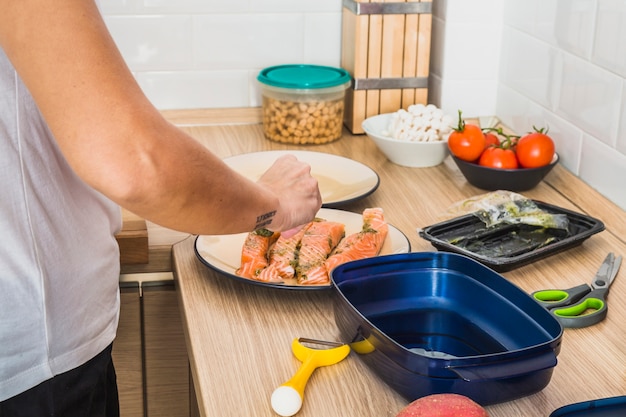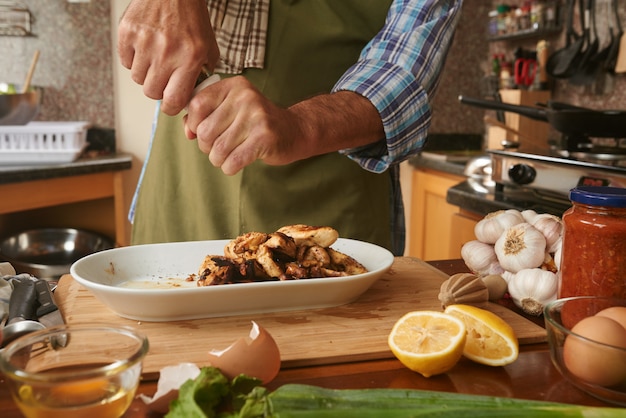Let's talk chicken thighs, my friends. I've been in the kitchen for years, and I've learned a few things about getting those juicy, tender thighs that melt in your mouth. You know, the kind that leaves you craving for more. Forget dry, overcooked chicken - we're going for flavour, texture, and pure, unadulterated satisfaction.
This isn't just a recipe - it's a whole journey. We'll cover everything from picking the perfect chicken at the supermarket to mastering the art of getting that golden-brown crust while ensuring the meat remains succulent. You'll find tips, tricks, and even a few sneaky shortcuts I've learned over the years. So, grab a comfy chair, a notepad, and let's get cooking!
(Part 1) Choosing the Right Chicken

The journey starts at the supermarket. Don't just grab the first pack of chicken thighs you see. Take a moment, have a good look, and choose wisely. Here's what I look for when picking the perfect chicken:
Skin on or Skin Off?
Honestly, I'm a big fan of skin-on chicken thighs. That skin adds so much flavour. It crisps up beautifully and gives you a lovely golden-brown crust. It's like a little bonus treat. But, if you're watching your fat intake, skinless is perfectly fine. Just be sure to give them a good pat dry before cooking to avoid any unwanted steam.
Bone-in or Boneless?
Bone-in thighs, in my opinion, are the way to go. The bone acts as a little heat conductor, helping the heat distribute evenly, resulting in more succulent meat. Plus, they're often cheaper, which is always a bonus! Boneless thighs are fine, but they tend to dry out a little quicker.
Don’t be Afraid to Ask!
Don't hesitate to ask your butcher for their recommendations. They're experts and can point you in the right direction. If you're unsure what to look for, just ask them to show you the thighs that are most juicy and tender. They'll be happy to help, I promise!
(Part 2) Getting Ready to Cook

Now you've got your chicken, it's time to prep. It’s not complicated, but there are a couple of crucial steps to make sure your chicken cooks evenly and stays juicy. Let's get those thighs prepped and ready to go!
Pat Them Dry
This might seem obvious, but it’s super important! Wet chicken will steam, not sizzle, leading to a soggy, pale exterior. Pat your thighs dry with kitchen paper, paying extra attention to the skin. Get rid of any excess moisture for a perfect sear.
Salt and Pepper
Salt and pepper are the backbone of any good chicken dish. Don’t be afraid to season generously. I like to salt my chicken about 30 minutes before cooking, which helps draw out moisture and flavour. Then, I give them a fresh grind of pepper just before hitting the pan. This gives the chicken a chance to really soak up the salt and develop a deeper flavour.
Add some Colour
For an extra boost of flavour, I like to rub my thighs with a little smoked paprika, garlic powder, or even a pinch of cayenne pepper. Don’t go overboard though, you want to enhance the natural flavours of the chicken, not mask them. A little goes a long way here, and it's all about finding that perfect balance.
(Part 3) Cooking the Chicken

Now for the fun part - the actual cooking. We're going to break down the process into easy-to-follow steps, so you can get those delicious thighs sizzling on your stovetop in no time.
Choosing Your Pan
I always reach for a cast iron skillet. It heats evenly and gets incredibly hot, which is perfect for getting that crispy skin and juicy meat. If you don’t have a cast iron, a heavy-bottomed stainless steel pan will do the trick. Just make sure it’s big enough to accommodate your chicken thighs without overcrowding them.
Heat Matters
Heat is key for those perfect crispy chicken thighs. Turn your stovetop to medium-high heat, or even high if you've got a cast iron skillet. Let the pan get really hot before adding the chicken. It should sizzle as soon as the chicken hits the surface. If the pan isn't hot enough, you'll end up with steamed chicken instead of crispy, deliciousness.
The Golden Rule
Don’t overcrowd the pan. If you’re cooking multiple thighs, cook them in batches. This will ensure they have enough space to brown evenly. Overcrowding the pan will make the chicken steam instead of sear, resulting in a soggy mess.
(Part 4) Don’t Touch!
This might be the hardest part. Resist the urge to move the chicken around immediately. Give it a good 5-7 minutes to develop a beautiful golden-brown crust. You'll know it's ready when it easily releases from the pan. Once it’s nicely browned on one side, carefully flip it over and cook for another 5-7 minutes.
Remember, we're aiming for a juicy interior, so don’t overcook. A little pink in the middle is perfectly fine. If you're worried about it being undercooked, you can always use a meat thermometer.
(Part 5) The internal temperature Test
If you’re unsure about whether your chicken is cooked through, use a meat thermometer. Insert it into the thickest part of the thigh, avoiding the bone. The safe internal temperature for chicken is 165°F (74°C).
If the thermometer reads a lower temperature, continue cooking the chicken for a few more minutes. Just make sure you don’t overcook it, or you’ll end up with dry, tough chicken.
(Part 6) Rest and Serve
Once your chicken is cooked, take it off the heat and let it rest for 5-10 minutes before serving. This allows the juices to redistribute throughout the meat, resulting in even more tender and flavourful chicken. Think of it as a little post-workout recovery for the chicken.
Serve your chicken with your favourite sides. I love a simple salad, roasted vegetables, or even some creamy mashed potatoes. You can also add a squeeze of lemon juice or a sprinkle of fresh herbs for an extra touch of flavour.
(Part 7) Variations and Extras
Chicken thighs are incredibly versatile. You can use them in so many different dishes, from simple stir-fries to complex curries. The possibilities are endless!
Get Creative with Flavour
Don’t be afraid to experiment with different seasonings and marinades. Here are a few ideas to get you started:
- Mediterranean Flavours: A blend of oregano, thyme, garlic, and lemon juice. This combination will give your chicken a bright, tangy flavour with a hint of Mediterranean charm.
- Spicy Kick: Combine paprika, cayenne pepper, garlic powder, and cumin. This blend will give your chicken a spicy kick that will satisfy those who love a little heat. Adjust the amount of cayenne pepper to your liking.
- Honey Garlic Glaze: Whisk together honey, soy sauce, garlic, ginger, and a touch of sesame oil. This sweet and savory glaze is perfect for adding a touch of umami to your chicken. It's also a great option for a sticky, delicious sauce.
Add some Veggies
For a one-pan meal, toss some vegetables like onions, bell peppers, or potatoes into the pan with the chicken. Just make sure to cook them at the same time. This is a great way to save time and create a complete meal in one go.
Smother with Sauce
Chicken thighs are perfect for a hearty sauce. Try a creamy mushroom sauce, a rich tomato sauce, or a tangy barbecue sauce. The chicken will soak up all the flavour and create a satisfyingly delicious dish.
(Part 8) FAQs
You've made it this far, you're a cooking pro now, but maybe you've still got a few burning questions. Let's tackle those:
Q: How do I make sure my chicken thighs are cooked through?
A: Use a meat thermometer to check the internal temperature. It should reach 165°F (74°C) in the thickest part of the thigh. Don't rely on the colour of the chicken alone, as this can be misleading.
Q: What should I do if my chicken thighs are a little dry?
A: Add a splash of liquid to the pan, like chicken broth or wine, and let it simmer for a few minutes to rehydrate the meat. You can also add a tablespoon of butter or a drizzle of olive oil to help add moisture and flavour.
Q: Can I cook chicken thighs in the oven?
A: Absolutely! Preheat your oven to 400°F (200°C) and roast the chicken thighs for about 25-30 minutes, or until they reach an internal temperature of 165°F (74°C). You can also try roasting them with vegetables for a complete meal.
Q: Can I freeze chicken thighs?
A: Yes, you can freeze chicken thighs for up to 2 months. Just make sure to wrap them tightly in plastic wrap or foil before freezing. This will prevent freezer burn and keep your chicken fresh.
Q: How can I make my chicken thighs extra crispy?
A: Before cooking, pat the chicken thighs dry with kitchen paper. When you’re ready to cook, use a hot pan, and don’t overcrowd it. You can also try lightly dredging the chicken in flour before cooking to create a crispy crust.
(Part 9) More Than Just Chicken Thighs
This guide is all about chicken thighs, but it’s really just a stepping stone. Once you’ve mastered these juicy beauties, you can branch out to other cuts of chicken. There's a whole world of chicken recipes waiting to be explored!
Remember, cooking is a journey, not a race. Don't be afraid to experiment, and have fun with it! And if you ever have any questions, feel free to drop me a line. I'm always happy to help fellow chicken enthusiasts!
Now, go forth and conquer those chicken thighs!
Everyone is watching

Corn on the Cob: The Ultimate Guide to Perfectly Cooked Ears
Healthy MealsAh, corn on the cob. Just the name evokes images of sunny days, barbecues, and that sweet, juicy flavour that ...

Perfect Pork Roast Oven Cooking Time: A Guide to Delicious Results
Healthy MealsThere's something truly satisfying about a perfectly roasted pork. The aroma alone is enough to make your mout...

Scallops: The Ultimate Guide to Perfect Cooking
Healthy MealsAh, scallops. Those delicate, sweet, and utterly delicious morsels of the sea. They hold a special place in my...

Ham Cooking Time: How Long to Bake, Smoke, or Boil a Delicious Ham
Healthy MealsAh, ham. It's a classic, isn't it? A real crowd-pleaser, especially around holidays. And when done right, it'...

Spaghetti Squash: The Ultimate Guide to Cooking and Serving
Healthy MealsRemember that time you saw spaghetti squash at the supermarket, looking all bumpy and strange, and thought, "W...
